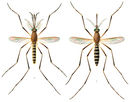Journal of Medical Entomology (2021) 58, 1210-1218
From Pestinfo-Wiki
 | Selected publication you are invited to contribute to the discussion section (above tab) |
Efficient monitoring of adult and immature mosquitoes through metabarcoding of bulk samples: A case study for non-model culicids with unique ecologies
Journal of Medical Entomology 58 (3), 1210-1218
Abstract: The rapid and economical monitoring of mosquitos is imperative to understanding the dynamics of both disease vectors and nuisance species. In light of technological advances in mosquito sampling and DNA sequencing, health agencies can now utilize the full potential of metabarcoding pipelines for rapid and standardizable surveillance. Here, we describe mosquito spatial and temporal variation, with particular focus on Mansonia Blanchard species, in the Madeira (Rondônia State) and the Ribeira (São Paulo) watersheds, Brazil using metabarcoding of the D2 rDNA marker. Sampling and molecular pipelines were used to evaluate the taxonomic contribution of mosquitos in pools of culicids collected en masse from macrophyte-roots (immatures) and from Mosquito Magnet traps and protected human landings (adults). Results for adult captures are comparable to morphological diagnoses and clarify previously unknown temporal and spatial species turnover. Metabarcoding of immature stages also confirmed the extent of the geographical distribution of some species and each taxon's association with macrophyte species. Given the benefits of metabarcoding, such as taxonomic acuity, high throughput processing, and objectivity, we suggest such techniques should be more fully incorporated into culicid monitoring schemes. The metabarcoding protocol described herein paired with standardized field sampling schemes, when used by mosquito monitoring professionals, offers substantial improvements in terms of practicality, speed and cost.
(The abstract is excluded from the Creative Commons licence and has been copied with permission by the publisher.)
Full text of article
Database assignments for author(s): Pedro M. Pedro, Maria Anice Mureb Sallum
Research topic(s) for pests/diseases/weeds:
surveys/sampling/distribution
Pest and/or beneficial records:
| Beneficial | Pest/Disease/Weed | Crop/Product | Country | Quarant. |
|---|---|---|---|---|
| Culex quinquefasciatus | Brazil (NW) | |||
| Aedes aegypti | Brazil (NW) | |||
| Anopheles albitarsis | Brazil (NW) | |||
| Mansonia titillans | Brazil (NW) | |||
| Mansonia amazonensis | Brazil (NW) | |||
| Mansonia humeralis | Brazil (NW) | |||
| Anopheles marajoara | Brazil (NW) | |||
| Mansonia indubitans | Brazil (NW) |